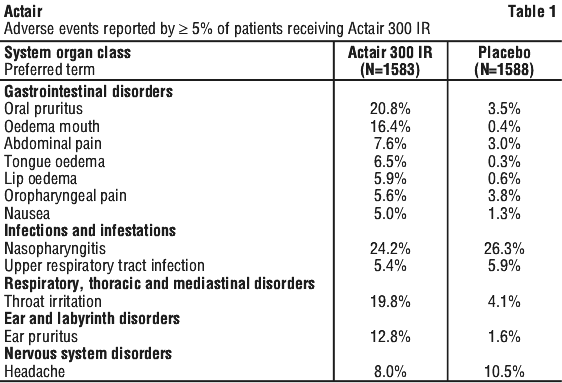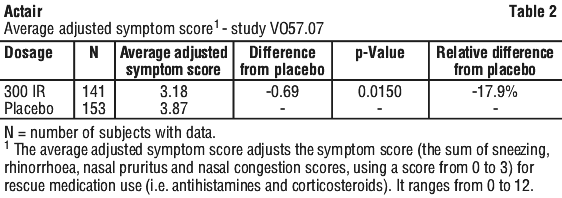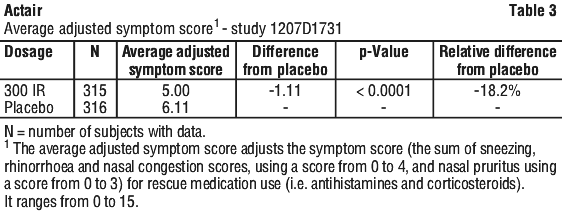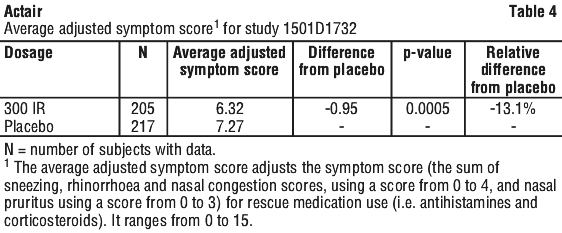SUMMARY CMI
ACTAIR®
Consumer Medicine Information (CMI) summary
The full CMI on the next page has more details. If you are worried about using this medicine, speak to your doctor or pharmacist.
1. Why am I using ACTAIR?
ACTAIR contains active ingredients which are a 50% mixture of allergen extracts from 2 species of house dust mite - American House Dust Mite and European House Dust Mite. ACTAIR is used for the treatment of house dust mite allergies that are characterised by rhinitis (sneezing, runny or itchy nose, nasal congestion) with or without conjunctivitis (itchy and watery eyes) in adults, adolescents and children 5 years and over
For more information, see Section 1. Why am I using ACTAIR? in the full CMI.
2. What should I know before I use ACTAIR?
Do not use if you have ever had an allergic reaction to any of the ingredients listed at the end of the CMI or if you suffer from severe and/or unstable asthma; your immune system is very weakened; if you suffer from a cancer; if you have any inflammation in your mouth
Talk to your doctor if you have any other medical conditions, take any other medicines, or are pregnant or plan to become pregnant or are breastfeeding. For more information, see Section 2. What should I know before I use ACTAIR? in the full CMI.
3. What if I am taking other medicines?
Some medicines may interfere with ACTAIR and affect how it works.
A list of these medicines is in Section 3. What if I am taking other medicines? in the full CMI.
4. How do I use ACTAIR?
The therapy is composed of an initiation treatment (including a 3-day dose escalation) and a continuation treatment.
The tablets are taken by keeping the tablet under your tongue until it is completely disintegrated (at least 2 minutes) before you swallow. More instructions can be found in Section 4. How do I use ACTAIR? in the full CMI.
5. What should I know while using ACTAIR?
| Things you should do | Remind any doctor, dentist or pharmacist you visit that you are using ACTAIR. You are advised to take the first tablet under medical supervision and be monitored for 30 minutes. Take these tablets as prescribed until the end of the treatment course. If you have to undergo surgery in the mouth or if you are having a tooth pulled, you should stop the treatment with ACTAIR for 7 days and ask your doctor how you should restart the treatment. |
| Things you should not do | Do not take food or beverage at the same time you are taking the medicine and for at least 5 minutes afterwards. Do not halve the tablet. Tablet is to be taken whole. If you forget to take ACTAIR, do not take a double dose to make up for forgotten dose. Do not start taking ACTAIR if you are pregnant. |
| Driving or using machines | No effect on the capacity to drive or use machines has been observed |
| Looking after your medicine | Store below 30°C. Store in the original package in order to protect from moisture |
For more information, see Section 5. What should I know while using ACTAIR? in the full CMI.
6. Are there any side effects?
Common side effects: Swelling or itching of the mouth, throat irritation and itchy ear.
Serious side effects: Allergic symptoms that affect the whole body, (i.e., rapid onset of an illness associated with involvement of the skin and/or mucosa, difficulties in swallowing, breathing difficulty, voices change, abdominal pain or symptoms related to drop in blood pressure). Serious allergic reaction with swelling of the face and/or mouth or tongue and throat. For more information, including what to do if you have any side effects, see Section 6. Are there any side effects? in the full CMI.
FULL CMI
ACTAIR® Pronounced (Act-air)
Active ingredient(s): Extracts of American House Dust Mite and European House Dust Mite
Consumer Medicine Information (CMI)
This leaflet provides important information about using ACTAIR. You should also speak to your doctor or pharmacist if you would like further information or if you have any concerns or questions about using ACTAIR.
Where to find information in this leaflet:
1. Why am I using ACTAIR?
2. What should I know before I use ACTAIR?
3. What if I am taking other medicines?
4. How do I use ACTAIR?
5. What should I know while using ACTAIR?
6. Are there any side effects?
7. Product details
1. Why am I using ACTAIR?
ACTAIR contains a 50% mixture of allergen extracts from 2 species of house dust mite. The house dust mites that ACTAIR is used for are: European house dust mite (Dermatophagoides pteronyssinus) and American house dust mite (Dermatophagoides farinae).
ACTAIR is an allergen extract from house dust mites. The treatment with ACTAIR is intended to increase the immunological tolerance towards house dust mites, and thereby reducing the allergic symptoms.
ACTAIR is used for the treatment of house dust mite allergies that are characterised by rhinitis (sneezing, runny or itchy nose, nasal congestion) with or without conjunctivitis (itchy and watery eyes) in adults, adolescents and children 5 years and over.
2. What should I know before I use ACTAIR?
Warnings
Do not use ACTAIR if:
- You are hypersensitive (allergic) to any of the other ingredients of ACTAIR;
- You suffer from severe and/or unstable asthma or you experienced severe asthma exacerbation within the last 3 months.
- Your forced expiratory volume in one second (FEV1) is below 80% as assessed by your doctor.
- You have an illness which affects the immune system, you are taking medicines which suppress the immune system or if you currently have cancer;
- You have any severe inflammation in your mouth (for example mouth ulcers, bleeding gums).
Check with your doctor if:
- You experience severe allergic symptoms, such as difficulty in swallowing or breathing, changes in your voice, hypotension (low blood pressure) or a feeling of a lump in the throat. Stop the treatment and contact your doctor immediately or go to the Emergency Department at your nearest hospital
- You have previously had a severe allergic reaction to a drug with allergen extracts.
- Your asthma symptoms get noticeably worse than normal. Stop treatment and contact your doctor immediately.
- You have a cardiovascular disease.
- You are taking a beta blocker (i.e. a class of drugs often prescribed for heart conditions and high blood pressure but also present in some eye drops and ointments), as this drug may decrease the effectiveness of adrenaline (epinephrine), a medicine used to treat serious allergic reactions.
- You are taking MAOIs, tricyclic antidepressants and COMT inhibitors. Allergen immunotherapy in patients treated with mono amine oxidase inhibitors (MAOIs) or tricyclic antidepressants or for Parkinson's disease with COMT inhibitors should be considered carefully as these treatments could potentiate the effect of adrenaline (epinephrine).
- You need mouth surgery or a tooth extraction, you should temporarily stop treatment with ACTAIR until completely healed.
- You experience persistent heartburn or difficulty swallowing. You should contact your doctor.
- You have an autoimmune disease in remission.
If you take asthma controller and/or reliever medications, do not interrupt your asthma treatment without your doctor's advice as this may worsen the asthma symptoms.
During treatment, you may be at risk of developing certain side effects. It is important you understand these risks and how to monitor for them especially if you have cardiovascular diseases. See additional information under Section 6. Are there any side effects?
Pregnancy and breastfeeding
Check with your doctor if you are pregnant or intend to become pregnant.
Do not start taking ACTAIR if you are pregnant.
Talk to your doctor if you are breastfeeding or intend to breastfeed.
Important information about some of the ingredients of ACTAIR
This medicine contains lactose. If you have been told by your doctor that you have intolerance to some sugars, contact your doctor before taking this medicinal product.
3. What if I am taking other medicines?
Tell your doctor or pharmacist if you are taking any other medicines, including any medicines, vitamins or supplements that you buy without a prescription from your pharmacy, supermarket or health food shop.
Some medicines may interfere with ACTAIR and affect how it works.
If you are taking other allergy medicines such as antihistamines, asthma relief medication or steroids or a medication that blocks a substance called immunoglobulin E (IgE) e.g. omalizumab, discuss with your doctor whether to continue taking them. Do not stop taking these medicines before talking to your doctor. If you stop taking those allergy medicines you may experience more side effects during ACTAIR treatment.
Check with your doctor or pharmacist if you are not sure about what medicines, vitamins or supplements you are taking and if these affect ACTAIR.
4. How do I use ACTAIR?
Always take ACTAIR exactly as your doctor has told you. Check with your doctor if you are not sure.
ACTAIR is prescribed by doctors with adequate training and experience in treatment of allergy. With prescriptions for adolescents and children 5 years and over, the doctor will have the relevant experience in the treatment of patients in this age group.
You are advised to take the first tablet under medical supervision and be monitored for 30 minutes. This gives you the possibility of discussing possible side effects with your doctor.
How much to take / use
Adults, adolescents and children 5 years and over
The treatment is composed of an initiation phase (including a 3-day dose escalation) and a continuation phase.
Initiation Treatment:
The treatment with ACTAIR should be initiated as follows:
| Day 1 | 1 tablet of 100 IR |
| Day 2 | 2 tablets of 100 IR at the same time |
| From day 3 | 1 tablet of 300 IR |
Continuation Treatment:
The dose is 300 IR (one tablet) each day.
Method of administration
It is recommended to take the tablets during the day in an empty mouth. Tablets should be placed under the tongue until complete disintegration (at least 2 minutes) and then swallowed. Food or beverage should not be taken for the following 5 minutes. On the first day, one 100 IR tablet should be taken. On the second day of treatment, two 100 IR tablets should be placed under the tongue simultaneously.
There is no experience with ACTAIR in children younger than 5 years and in patients over 65 years of age.
How long ACTAIR should be taken for?
ACTAIR is started on the day determined by your doctor. Take these tablets as prescribed by your doctor until the end of the treatment course.
It is recommended to maintain the treatment all year round.
After one year of treatment, efficacy has been shown to be maintained in the following year without treatment.
Each year your doctor will assess if it is suitable for you to continue ACTAIR treatment.
If you forget to use ACTAIR
ACTAIR should be used regularly every day as per above dosing scheme.
If it is almost time for your next dose, skip the dose you missed and take your next dose when you are meant to.
Do not take a double dose to make up for the dose you missed.
If you interrupted the treatment with ACTAIR for less than one week, you can take up treatment where you left off. If you interrupt treatment for longer than 7 days, you should ask your doctor before restarting treatment
If you have any further questions on the use of this product, ask your doctor.
If you use too much ACTAIR
If you think that you have used too much ACTAIR, you may need urgent medical attention.
You should immediately:
- phone the Poisons Information Centre
(by calling 13 11 26 in Australia and 0800 POISON (0800 764 766) in New Zealand), or - contact your doctor, or
- go to the Emergency Department at your nearest hospital.
You should do this even if there are no signs of discomfort or poisoning.
5. What should I know while using ACTAIR?
Things you should do
Call your doctor straight away if you:
- You experience any infection or inflammation in the mouth or if you experience an increase in asthma or allergy symptoms, ask your doctor for advice before continuing treatment with ACTAIR
- Have to undergo surgery in the mouth or if you are having a tooth pulled, you should stop the treatment with ACTAIR for 7 days to allow your oral cavity to heal. Thereafter, restart the treatment with the previous dosage. If you stopped the treatment for more than 7 days, please ask your doctor how you should restart the treatment.
- If you become pregnant, speak to your doctor about whether it is appropriate for you to continue treatment.
Remind any doctor, dentist or pharmacist you visit that you are using ACTAIR.
Things you should not do
Do not take food or beverage at the same time you are taking the medicine and for at least 5 minutes afterwards.
Do not halve the tablet. Tablet is to be taken whole.
If you forget to take ACTAIR, do not take a double dose to make up for forgotten dose.
Driving or using machines
No effect on the capacity to drive or use machines has been observed with ACTAIR.
Looking after your medicine
Keep it in the original pack in order to protect from moisture.
Keep it below 30°C.
Store it in a cool dry place away from moisture, heat or sunlight; for example, do not store it:
in the bathroom or near a sink, or
in the car or on window sills.
Keep it where young children cannot reach it.
When to discard your medicine (as relevant)
Do not use if past the expiry date which is stamped on the carton side panel.
Getting rid of any unwanted medicine
If you no longer need to use this medicine or it is out of date, take it to any pharmacy for safe disposal.
6. Are there any side effects?
All medicines can have side effects. If you do experience any side effects, most of them are minor and temporary. However, some side effects may need medical attention.
See the information below and, if you need to, ask your doctor or pharmacist if you have any further questions about side effects.
Do not be alarmed by the following list of side effects. You may not experience any of them.
During treatment with ACTAIR, you will be exposed to substances that may cause application site reactions (such as itching of the mouth and throat irritation).
Stop taking ACTAIR and contact your doctor immediately if you develop or notice:
- Allergic symptoms that affect the whole body (i.e. rapid onset of an illness associated with involvement of the skin and/or mucosa, difficulties in swallowing, breathing difficulty, voices changes, abdominal pain or symptoms related to a drop in blood pressure).
- Serious allergic reaction with swelling of the face and/or mouth or tongue and throat.
Other possible serious side effects include the following:
Serious side effects in adults and adolescents
| Serious side effects | What to do |
[Nose/mouth/throat]
| Stop taking ACTAIR and Call your doctor straight away, or go straight to the Emergency Department at your nearest hospital if you notice any of these serious side effects. |
Less serious side effects in adults and adolescents
| Less serious side effects | What to do |
[Eye/ear]
| Speak to your doctor if you have any of these less serious side effects and they worry you. |
Additional less serious side effects in children
| Less serious side effects in children | What to do |
[Eye]
| Speak to your doctor if you have any of these less serious side effects and they worry you. |
In children, the following side effects were reported at a higher frequency than in adults and adolescents: discomfort in the back of the throat, vomiting, hives and abnormal blood results were reported as common (affecting less than 10 in 100 people and more than 1 in 100 people), eye redness and voice box irritation were reported as uncommon (affecting less than 1 in 100 people).
Additional side effects experienced with similar products
As with any sublingual allergen immunotherapy, cases of oesophageal inflammation have been reported with ACTAIR.
Tell your doctor or pharmacist if you notice anything else that may be making you feel unwell.
Other side effects not listed here may occur in some people.
Reporting side effects
After you have received medical advice for any side affects you experience, you can report side effects to the Therapeutic Goods Administration online at www.tga.gov.au/reporting-problems or Medsafe (New Zealand) at www.medsafe.govt.nz/safety/report-a-problem.asp
by reporting side effects, you can help provide more information on the safety of this medicine.
Always make sure you speak to your doctor or pharmacist before you decide to stop taking any of your medicines.
7. Product details
This medicine is only available with a doctor's prescription.
What ACTAIR contains
| Active ingredient (main ingredient) | Extract of European house dust mite Extract of American house dust mite |
| Other ingredients (inactive ingredients) | Mannitol, Microcrystalline cellulose, Croscarmellose sodium, Colloidal anhydrous silica, Magnesium stearate and Lactose monohydrate. |
Do not take this medicine if you are allergic to any of these ingredients.
What ACTAIR looks like
ACTAIR Initiation Treatment sublingual tablets 100 IR and 300 IR contain a small blister with 3 tablets of 100 IR concentration and a large blister with 28 tablets of 300 IR concentration
OR
ACTAIR Initiation Treatment sublingual tablets 100 IR and 300 IR contain a small blister with 3 tablets of 100 IR concentration and a three large blisters with respectively 28, 30 and 30 tablets of 300 IR concentration
OR
ACTAIR Initiation Treatment sublingual tablets 100 IR and 300 IR contain a small blister with 3 tablets of 100 IR concentration and a large blister with 7 tablets of 300 IR concentration.
ACTAIR Continuation Treatment sublingual tablets 300 IR contain blisters with 30 tablets of 300 IR concentration. The continuation treatment is available in packs of 30 or 90 tablets.
The tablets are round, biconvex, white to beige, brown speckled. The 100 IR tablets are engraved “SAC” on one side and “100” on the other and the 300 IR tablets are engraved SAC” on one side and “300” on the other.
The following pack sizes are available:
ACTAIR Initiation Treatment sublingual tablets 100 IR and 300 IR (AUST R 233470 in Australia and TT50-9711 in New Zealand)
- Pack with 3 tablets 100 IR and 28 tablets 300 IR
- Pack with 3 tablets 100 IR and 88 tablets 300 IR
- Pack with 3 tablets 100 IR and 7 tablets 300 IR
ACTAIR Continuation Treatment sublingual tablets 300 IR (AUST R 233471 in Australia and TT50-9711-1 in New Zealand)
- Pack with 30 tablets
- Pack with 90 tablets
Who distributes ACTAIR
NAME AND ADDRESS OF THE SPONSOR IN AUSTRALIA:
Stallergenes Australia Pty Ltd
Suite 2408,
4 Daydream St.,
Warriewood, NSW 2102
Ph: 1800 824 166
Fax: 1800 824 199
NAME AND ADDRESS OF THE SPONSOR IN NEW ZEALAND:
Stallergenes Greer New Zealand Limited
Level 1, 24 Manukau Road,
Epsom, Auckland 1023
New Zealand
Ph: 0800 824 166
This leaflet was prepared in 30 November 2023
Published by MIMS April 2024



 Adverse events with an incidence < 5% and with causality assigned to Actair are listed below according to the MedDRA convention by system organ class and by frequency common: ≥ 1/100, < 1/10, uncommon: ≥ 1/1,000, < 1/100, rare: ≥ 1/10,000, < 1/1,000.
Adverse events with an incidence < 5% and with causality assigned to Actair are listed below according to the MedDRA convention by system organ class and by frequency common: ≥ 1/100, < 1/10, uncommon: ≥ 1/1,000, < 1/100, rare: ≥ 1/10,000, < 1/1,000. Patients receiving the 300 IR dose had a lower average rhinitis total symptom score by 18.5% than those receiving placebo. There was no difference in the average rescue medication score between the active and placebo treatment groups.
Patients receiving the 300 IR dose had a lower average rhinitis total symptom score by 18.5% than those receiving placebo. There was no difference in the average rescue medication score between the active and placebo treatment groups. In the subset of adolescents (aged 12 to 17 years), patients receiving the 300 IR dose had a lower average adjusted symptom score by 26.9% than those receiving placebo.
In the subset of adolescents (aged 12 to 17 years), patients receiving the 300 IR dose had a lower average adjusted symptom score by 26.9% than those receiving placebo. Patients receiving the 300 IR dose had a lower Average Rhinitis Total Symptom Score by 12.7% and a lower Average Rescue Medication Score by 8.5% than those receiving placebo.
Patients receiving the 300 IR dose had a lower Average Rhinitis Total Symptom Score by 12.7% and a lower Average Rescue Medication Score by 8.5% than those receiving placebo.